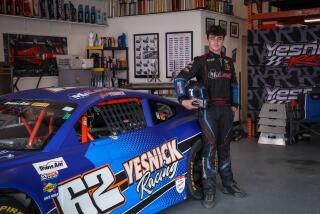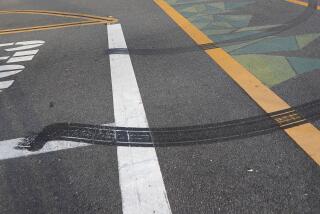The Ferrari 488 Pista brings racetrack performance to California freeways
Companies that build performance sports cars, trying to sell steak and sizzle at the same time, continue to offer vehicles that increasingly erase the space between street cars and track cars.
McLaren, Lamborghini, Ferrari and Porsche all build vehicles now that are street legal but track-ready, for the driver who either wants to take his or her European road warrior for a few laps around Thermal or Willow Springs, or, just as likely, wants other people to think he or she actually does so.
With the new 488 Pista — “pista” means “track” in Italian — Ferrari has narrowed the space even further, putting an enormous amount of track technology into a street car that is designed, in the company’s words, “to offer a race-like experience even to non-professional drivers.”
The Pista, which replaces the 458 Speciale in the Ferrari line, is driven by the most powerful V8 engine Ferrari has ever put in a road car and is built with the most track technology Ferrari has ever added to a street-going vehicle.
The explosive 3.9-liter, twin-turbocharged motor makes 711 horsepower and 568 pound-feet of torque, inside a sleek body and upgraded chassis that offer the lowest power-to-weight ratio of any car Ferrari has ever sold to the public.
The result: The 488 Pista accelerates from zero to 62 miles per hour (100 kilometers per hour; this is a European car) in 2.85 seconds, and to 124 mph in 7.6 seconds. Top speed is said to be 211 mph.
That’s fast. Racetrack fast. Absurdly fast. Ferrari achieved the performance statistics largely through weight reduction and improved aerodynamics borrowed from Ferrari’s F1, Challenge, GTE and FXX-K race cars. A full 198 pounds lighter than its predecessor, the Pista is loaded with carbon fiber and other lightweight materials, and its driving dynamics have been improved by the altered aerodynamics. Ferrari promises its prospective owners that they will experience “race-like agility,” “instantaneous braking” and “confidence when on the limit.”
I was not able to even approach the limit or sneak in any hot laps during my time with the Pista, but I did have the opportunity to spin it around some of our local highways and canyon roads, and it is a thrilling car to drive. Ferrari has managed to pair so much raw power with so many technological refinements that the experience is almost elegant.
The Pista, while breathtakingly quick, accelerated smoothly, climbing through the gears seamlessly and without any discernible turbo lag.
Despite the horsepower, the car seemed almost to drive itself. Steering and handling were intuitive. Braking was surgical. The low-slung Ferrari felt glued to the pavement.
By my standards the Pista is a beautiful car — even among Ferraris, which are all beautiful. The sensual lines evoke both poise and power. Even standing still it looks fast.
Like all Ferraris, too, the Pista sounds beautiful, issuing a gravelly grumble tuned, in the case of the model I drove, through a titanium exhaust.
The driving experience felt race-like even when I was stuck in traffic. (Notably, the driving modes are “Race,” “Sport” and “Wet.” There is no “Standard” or “Normal” here.) The tidy but not uncomfortable cockpit was equipped with minimally adjustable race seats and a racing steering wheel with paddle shifters taken from Ferrari’s 488 Challenge track car.
Inside, I felt swaddled in the optional black Alcantara upholstery, from seat trim to wall trim to center console. The sleek dash, black accented in red, offered minimal distractions. A six-point harness is a race-ready option.
Though this model was equipped with an upgraded sound system, all the music I needed was coming from the exhaust pipes. I similarly did not engage the cruise-control system, which seemed like a dainty adornment on this car.
The price of speed is high, and all that lighter, quicker, faster costs money. The Ferrari race division spends millions upon millions of dollars turning its cars into race winners. So the cost of the street-legal race car is high, too.
The Pista starts at $350,050. The model I drove was tarted up with lashings of additional track-derived options, particularly in the form of carbon-fiber parts used to replace heavier materials. From engine covers to rear diffuser, this Pista was laden with more than $50,000 in carbon-fiber parts alone. That drove the price of this model to $445,437, including delivery charges and the $1,000 gas-guzzler tax the government applies to some performance cars.
Those MSRP numbers may interest potential buyers less than the zero-to-60 statistic. Ferrari in its press materials says that 75% of Pista buyers already own a Ferrari, that 25% of those already own another V8 performance car, and that 60% of them participate in track events. Those customers already understand that it costs a lot of money to go fast.
Ferrari had a good 2019. The company reported a 10% increase in global revenue, driven by a 15% rise in revenue from vehicle and parts sales. But unit sales were down 3% in the combined North and South American market, which traditionally accounts for a third of all Ferrari car sales.
The 488 Pista may reverse that. It’s a great California car and — with racetracks in Willow Springs, Buttonwillow, Fontana and Thermal all within a three-hour range — a great car for L.A.
Ferrari 488 Pista
Times’ take: Ferrari’s most powerful V8 road car
Highs: Brilliant engine matched by sophisticated electronics
Lows: Quite a wallop to the wallet
Vehicle type: Two-door, two-passenger sports car
Base price: $350,050
Price as tested: $455,437
Powertrain: 3.9-liter, twin-turbocharged V8 gasoline engine
Transmission: Seven-speed dual-clutch automatic
Horsepower: 711
Torque: 568 pound-feet
Estimated fuel economy rating: 15 miles per gallon city / 20 highway / 17 combined







